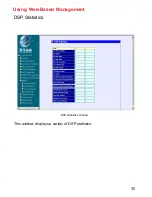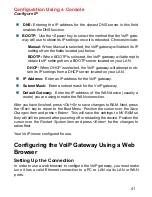
37
Configuration Using a Console
Setting up a Console
First-time configuration can be carried out through a “console,” that is, either
(a) a VT100-type serial data terminal, or (b) a computer running communications
software set to emulate a VT100. The console must be connected to the
Diagnostics port. This is an RS-232 port with a 9-socket D-shell connector and
DCE-type wiring. Make the connection as follows:
1. Obtain suitable cabling for the connection.
You can use either (a) a “null-modem” RS-232 cable or (b) an ordinary RS-
232 cable and a null-modem adapter. One end of the cable (or cable/adapter
combination) must have a 9-pin D-shell connector suitable for the
Diagnostics port; the other end must have a connector suitable for the
console’s serial communications port.
2. Power down the devices, attach the cable (or cable/adapter combination)
to the correct ports, and restore power.
3. Set the console to use the following communication parameters for your
terminal:
9600 baud
VT-100/ANSI compatible
No parity checking (sometimes referred to as “no parity”)
8 data bits (sometimes called a “word length” of 8 bits)
1 stop bit (sometimes referred to as a 1-bit stop interval)
No Flow control
Arrow keys enabled
















































